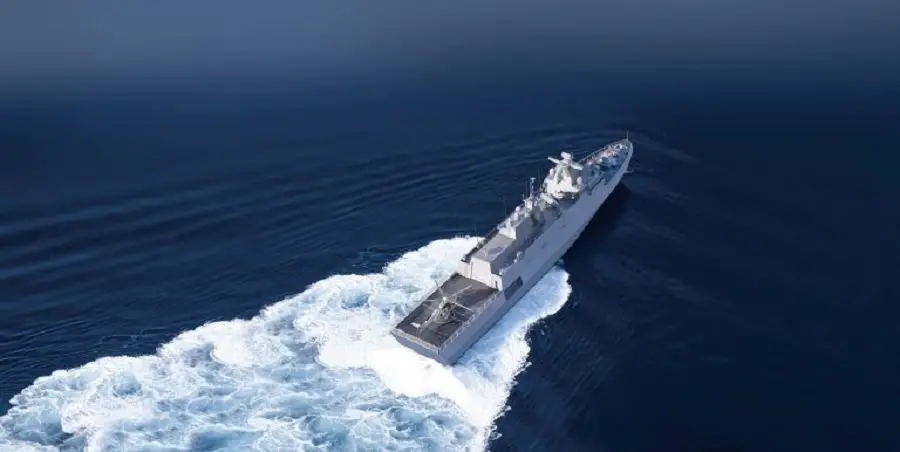On March 24th, the Brazilian Navy and Águas Azuis, a special purpose entity (SPE) formed by thyssenkrupp Marine Systems, Embraer Defense & Security and Atech, celebrated another milestone in the construction of the Tamandare frigate: the ship’s keel laying. The ceremony, which took place at thyssenkrupp Estaleiro Brasil Sul in Itajaí, Santa Catarina, was attended by the Commander of the Navy Fleet Admiral Marcos Sampaio Olsen, and other civil and military authorities from the defense sector and the naval industry. Traditionally celebrated in shipbuilding, the keel laying takes place when the keel, the “backbone” of the vessel, is completed, allowing the construction of the other parts. Nowadays, with the engineering evolution and the modern production processes adopted in the Tamandare Class Frigates Program (PFCT). In the case of the Tamandare frigate, the first of the four ships in the PFCT, the keel laying was characterized by the positioning at its building site of an important structural block, which corresponds to the forward engine room. In this metal structure, which weighs approximately 52 tons, two engines, a gearbox and several pumps and auxiliary equipment will be installed.
The Tamandare class are a new class of future general purpose frigates for the Brazilian Navy, based on the MEKO family of ships. The MEKO family of warships was developed by the German company Blohm+Voss. MEKO is a registered trademark. The portmanteau stands for “Mehrzweck-Kombination” (English: multi-purpose-combination). It is a concept in modern naval shipbuilding based on modularity of armament, electronics and other equipment, aiming at ease of maintenance and cost reduction. The project is being developed by the Ministry of Defence and the Águas Azuis consortium, composed of ThyssenKrupp Marine Systems (TKMS) and Embraer Defense & Security. The Tamandare class are a new class of future general purpose frigates for the Brazilian Navy, based on the MEKO family of ships. The project is being developed by the Ministry of Defence and the Águas Azuis consortium, composed of ThyssenKrupp Marine Systems (TKMS) and Embraer Defense & Security.
Conducted since 2017 by the Brazilian Navy, executed by Aguas Azuis and managed by Empresa Gerencial de Projetos Navais (EMGEPRON), the Tamandare Class Frigates Program is the most modern and innovative naval project developed in the country, comprising the building, within national territory, of four defense ships of high technological complexity. The vessels must reach operational capacity to respond and protect the “Blue Amazon”, generating technology transfer and perpetual license, and promoting local industry and civil construction in the country. The Brazilian Navy predicts that the program, as a whole, could create around 2,000 direct jobs and 6,000 indirect jobs. On June 21st, 2022, a prototype of the engine room compartment section was completed; this is used for the qualification of various processes related to the manufacture of the vessels. As a highlight of the stages already carried out, the hull plate of the first Tamandare.

Fleet Admiral Arthur Fernando Bettega Corrêa, General Director of Navy Materiel, highlighted the importance of this ritual: “Today, we witnessed the meeting of tradition with compelling technological modernity, resulting in the optimization of production and increased security for both employees and information.”
Oliver Burkhard, CEO of thyssenkrupp Marine Systems, added: “We will provide the Brazilian Navy with high-end frigates that combine the edge of naval technology, innovation and robust combat capabilities and that will contribute greatly to Brazil’s national security in protecting the Amazônia Azul and beyond.”
The construction model, which provides for production in blocks to be joined later, offers several advantages over the old method. In this way, it is possible to install accessories and foundations in advance, in addition to facilitating the placement of equipment on board and enabling work to proceed in different stages in a segregated manner for each unit. The process also increases employee safety by keeping spaces open longer during construction. The innovations involved in the PFCT extend throughout the entire production chain. Historically, projects of this size are developed from a large number of printed documents, such as drawings, procedures and manuals, which require many copies and recurring updates. In this sense, the shipyard has implemented a methodology for engineering projects called “Paperless”, which consists of eliminating the use of paper drawings in the frigate’s production line, transforming them into digital files. This approach brings advantages for the information security of the documents, due to the confidentiality required in a military project, and also benefits the environment.
The state of PFCT construction is advancing within schedule, and currently represents 34 % of its total evolution. For the next stages, it is planned to build the block that forms the aft engine room, with the positioning of the equipment and engines in place. Next, the built blocks will complete the central structures of the ship. It should be noted that, of the more than fifty structural units that make up the construction sequence of the first Tamandaré Class frigate, about a quarter are in the process of structural assembly at thyssenkrupp Estaleiro Brasil Sul, and others are already cut and shaped, with panels and subassemblies completed. As for the qualification of the personnel who will be responsible for maintaining the ship’s systems, around 50 % of the activities regarding systems engineering and integrated logistic support have already been concluded. The launch of the Tamandaré frigate is estimated for mid-2024 and its delivery to the Brazilian Navy at the end of 2025. The cutting of the hull plate of the second Tamandaré Class frigate is expected to take place later this year.











